Seismic Characteristics and Development of the Upper Jurassic Carbonate Buildups from the Miechów Trough (Southern Poland)
Abstract
1. Introduction
2. Geological Setting
2.1. The Permian–Mesozoic Polish Basin
2.2. Late Jurassic Depositional System in Southern Poland: An Overview
2.3. The Upper Jurassic in the Miechów Trough and Adjacent Areas
3. Data and Methods
3.1. Well Data
3.2. Seismic Data
3.3. Methods of Data Integration and Interpretation
3.4. Seismic Attributes
4. Results
4.1. Well-to-Seismic Tie and Seismic-Stratigraphic Context
4.2. Interpretation of Seismic Data
4.2.1. Structural Interpretation of Seismic Data
4.2.2. Seismic Facies Analysis
4.2.3. Seismic Attribute Analysis
5. Discussion
5.1. Limitations and Potential Factors Influencing Seismic Expression of Carbonate Rocks
5.2. Role of Differential Compaction
5.3. Development of Carbonate Buildups
5.3.1. Internal Structure of the Carbonate Buildup Complex
5.3.2. Deposits of the Gravity Mass-flows
5.3.3. Marly Zone
5.3.4. Facies and Depositional Architecture
5.3.5. Comments on the Selected Factors Controlling the Initiation of Carbonate Buildups Development
5.3.6. Development of Carbonate Buildups—Conceptual Model Based on Seismic Data
5.4. Paleogeography of Carbonate Buildups in Southern Poland
6. Summary and Conclusions
Author Contributions
Funding
Acknowledgments
Conflicts of Interest
References
- Leinfelder, R.R. Upper Jurassic reef types and controlling factors. A preliminary report. Profil 1993, 5, 1–45. [Google Scholar]
- Leinfelder, R.R.; Krautter, M.; Laternser, R.; Nose, M.; Schmid, D.U.; Schweigert, G.; Werner, W.; Keupp, H.; Brugger, H.; Herrmann, R.; et al. The origin of Jurassic reefs: Current research developments and results. Facies 1994, 31, 1–56. [Google Scholar] [CrossRef]
- Leinfelder, R.R.; Schmid, D.U.; Nose, M.; Werner, W. Jurassic reef patterns—the expression of a changing globe. In Phanerozoic Reef Patterns; Kiessling, W., Flügel, E., Golonka, J., Eds.; Society for Sedimentary Geology: Tulsa, OK, USA, 2002; Volume 72, pp. 465–520. [Google Scholar] [CrossRef]
- Matyszkiewicz, J. Microfacies, sedimentation and some aspects of diagenesis of Upper Jurassic sediments from the elevated part of the Northern peri-Tethyan Shelf: A comparative study on the Lochen area (Schwäbische Alb) and the Cracow area (Cracow–Wielun Upland, Poland). Berl. Geowiss. Abh. 1997, 21, 1–111. [Google Scholar]
- Kiessling, W.; Flügel, E.; Golonka, J. Paleoreef Maps: Evaluation of a Comprehensive Database on Phanerozoic Reefs. AAPG Bull. 1999, 83, 1552–1587. [Google Scholar]
- Leinfelder, R.R.; Werner, W.; Nose, M.; Schmid, D.U.; Krautter, M.; Laternser, R.; Takacs, M.; Hartmann, D. Paleoecology, growth parameters and dynamics of coral, sponge and microbolite reefs from the Late Jurassic. Gött. Arb. Geol. Paläont. Sb. 1996, 2, 227–248. [Google Scholar]
- Guo, L.; Vincent, S.J.; Lavrishchev, V. Upper Jurassic Reefs from the Russian Western Caucasus: Implications for the Eastern Black Sea. Turk. J. Earth Sci. 2011, 20, 629–653. [Google Scholar] [CrossRef]
- Krajewski, M.; Schlagintweit, F. Crescentiella-microbial-cement microframeworks in the Upper Jurassic reefs of the Crimean Peninsula. Facies 2018, 64, 21:1–21:16. [Google Scholar] [CrossRef]
- Nikishin, A.M.; Okay, A.; Tüysüz, O.; Demirer, A.; Wannier, M.; Amelin, N.; Petrov, E. The Black Sea basins structure and history: New model based on new deep penetration regional seismic data. Part 1: Basins structure and fill. Mar. Petrol. Geol. 2015, 59, 638–655. [Google Scholar] [CrossRef]
- Nikishin, A.M.; Okay, A.; Tüysüz, O.; Demirer, A.; Wannier, M.; Amelin, N.; Petrov, E. The Black Sea basins structure and history: New model based on new deep penetration regional seismic data. Part 2: Tectonic history and paleogeography. Mar. Petrol. Geol. 2015, 59, 656–670. [Google Scholar] [CrossRef]
- Golonka, J. Plate tectonic evolution of the southern margin of Eurasia in the Mesozoic and Cenozoic. Tectonopysics 2004, 381, 235–273. [Google Scholar] [CrossRef]
- Cecca, F.; Martin Garin, B.; Lathhuiliere, B.; Bartolini, A. Paleoclimatic control of biogeographic and sedimentary events in Tethyan and peri-Tethyan areas during the Oxfordian (Late Jurassic). Palaeogeogr. Palaeoclimatol. Palaeoecol. 2005, 222, 10–32. [Google Scholar] [CrossRef]
- Rais, P.; Louis-Schmid, B.; Bernasconi, S.M.; Weissert, H. Palaeoceanographic and palaeoclimatic reorganization around the Middle–Late Jurassic transition. Palaeogeogr. Palaeoclimatol. Palaeoecol. 2007, 251, 527–546. [Google Scholar] [CrossRef]
- Wierzbowski, H.; Anczkiewicz, R.; Pawlak, J.; Rogov, M.A.; Kuznetsov, A.B. Revised Middle–Upper Jurassic strontium isotope stratigraphy. Chem. Geol. 2017, 466, 239–255. [Google Scholar] [CrossRef]
- Kendall, C.G.S.C.; Schlager, W. Carbonates and relative changes in sea level. Mar. Geol. 1981, 44, 181–212. [Google Scholar] [CrossRef]
- Gutowski, J.; Popadyuk, I.V.; Olszewska, B. Late Jurassic-earliest Cretaceous evolution of the epicontinental sedimentary basin of southeastern Poland and Western Ukraine. Geol. Q. 2005, 49, 31–44. [Google Scholar] [CrossRef]
- Krajewski, M.; Olchowy, P.; Felisiak, I. Late Jurassic facies architecture of the Złoczew Graben: Implications for evolution of the tectonic-controlled northern peri-Tethyan shelf (Upper Oxfordian–Lower Kimmeridgian, Poland). Facies 2016, 62, 4:1–4:19. [Google Scholar] [CrossRef][Green Version]
- Matyja, B.A. Development of the Mid-Polish Trough versus Late Jurassic evolution in the Carpathian Foredeep area. Geol. Q. 2009, 51, 49–62. [Google Scholar]
- Olchowy, P.; Krajewski, M.; Felisiak, I. Late Jurassic facies succession of the Kleszczów Graben area (southern border of the Łódź Depression, peri-Tethyan shelf, central Poland). Geol. Q. 2019, 63, 657–681. [Google Scholar] [CrossRef]
- Krajewski, M.; Matyszkiewicz, J.; Król, K.; Olszewska, B. Facies of the Upper Jurassic–Lower Cretaceous deposits from the southern part of the Carpathian Foredeep basement in the Kraków–Rzeszów area (southern Poland). Ann. Soc. Geol. Pol. 2011, 81, 269–290. [Google Scholar]
- Olszewska, B.; Matyszkiewicz, J.; Król, K.; Krajewski, M. Correlation of the Upper Jurassic-Cretaceous epicontinental sediments in southern Poland and south western Ukraine based on thin section. Biul. Państw. Inst. Geol. 2012, 453, 29–80. [Google Scholar]
- Urbaniec, A. Lithofacial development of the Upper Jurassic and Lower Cretaceous Deposits in the Dąbrowa Tarnowska-Dębica Area Based on the 3D Seismic Interpretation. Ph.D. Thesis, AGH University of Science and Technology, Kraków, Poland, November 2018. (In Polish). [Google Scholar]
- Burne, R.V.; Moore, L.S. Microbialites: Organosedimentary Deposits of Benthic Microbial Communities. Palaois 1987, 2, 241–254. [Google Scholar] [CrossRef]
- Riding, R. Microbial carbonates: The geological record of calcified bacterial–algal mats and biofilms. Sedimentology 2000, 47, 179–214. [Google Scholar] [CrossRef]
- Riding, R. Structure and composition of organic reefs and carbonate mud mounds: Concepts and categories. Earth-Sci. Rev. 2002, 58, 163–231. [Google Scholar] [CrossRef]
- Gwinner, M.P. Carbonate rocks of the Upper Jurassic in SW-Germany. In Sedimentology of Parts of Central Europe; Müller, G., Ed.; Kramer: Frankfurt, Germany, 1971; pp. 193–207. [Google Scholar]
- Matyszkiewicz, J.; Krajewski, M.; Kędzierski, J. Origin and evolution of an Upper Jurassic complex of carbonate buildups from Zegarowe Rocks (Kraków–Wieluń Upland, Poland). Facies 2006, 52, 249–263. [Google Scholar] [CrossRef]
- Matyszkiewicz, J.; Kochman, A.; Duś, A. Influence of local sedimentary conditions on development of microbialites in the Oxfordian carbonate buildups from the southern part of the Kraków-Częstochowa Upland (south Poland). Sediment. Geol. 2012, 263–264, 109–132. [Google Scholar] [CrossRef]
- Bubb, J.N.; Hatlelid, W.G. Seismic stratigraphy and global changes of sea level, Part 10: Seismic recognition of carbonate buildups. In Seismic Stratigraphy—Applications to Hydrocarbon Exploration; Payton, C.E., Ed.; American Association of Petroleum Geologists: Tulsa, OK, USA, 1977; Volume 26, pp. 185–204. [Google Scholar] [CrossRef]
- Blendinger, W.; Bowlin, B.; Zijp, F.R.; Darke, G.; Ekroll, M. Carbonate buildup flank deposits: An example from the Permian (Barents Sea, northern Norway) challenges classical facies models. Sediment. Geol. 1997, 112, 89–103. [Google Scholar] [CrossRef]
- Elvebakk, G.; Hunt, D.W.; Stemmerik, L. From isolated buildups to buildup mosaics: 3D seismic sheds new light on upper Carboniferous–Permian fault controlled carbonate buildups, Norwegian Barents Sea. Sediment. Geol. 2002, 152, 7–17. [Google Scholar] [CrossRef]
- Belopolsky, A.V.; Droxler, A.W. Seismic Expressions and Interpretation of Carbonate Sequences: The Maldives Platform, Equatorial Indian Ocean. AAPG Stud. Geol. 2004, 49, 49:1–49:66. [Google Scholar] [CrossRef]
- Zampetti, V.; Schlager, W.; van Konijnenburg, J.H.; Everts, A.J. Architecture and growth history of a Miocene carbonate platform from 3D seismic reflection data; Luconia Province, offshore Sarawak, Malaysia. Mar. Petrol. Geol. 2004, 21, 517–534. [Google Scholar] [CrossRef]
- Fournier, F.; Borgomano, J. Geological significance of seismic reflections and imaging of the reservoir architecture in the Malampaya gas field (Philippines). AAPG Bull. 2007, 91, 235–258. [Google Scholar] [CrossRef]
- Rafaelsen, B.; Elvebakk, G.; Andreassen, K.; Stemmerik, L.; Colpaert, A.; Samuelsberg, T.J. From detached to attached carbonate buildup complexes—3D seismic data from the upper Palaeozoic, Finnmark Platform, southwestern Barents Sea. Sediment. Geol. 2008, 206, 17–32. [Google Scholar] [CrossRef]
- Burgess, P.M.; Winefield, P.; Minzoni, M.; Elders, C. Methods for identification of isolated carbonate buildups from seismic reflection data. AAPG Bull. 2013, 97, 1071–1098. [Google Scholar] [CrossRef]
- Saqab, M.M.; Bourget, J. Seismic geomorphology and evolution of early mid Miocene isolated carbonate build-ups in the Timor Sea, North West Shelf of Australia. Mar. Geol. 2016, 369, 224–245. [Google Scholar] [CrossRef]
- Philips, T.; Jackson, C.A.L.; Bell, R.; Valencia, A. Rivers, reefs, and deltas; Geomorphological evolution of the Jurassic of the Farsund Basin, offshore southern Norway. Petrol. Geosci. 2019, 26, 81–100. [Google Scholar] [CrossRef]
- Veeken, P.; van Moerkerken, B. Seismic Stratigraphy and Depositional Facies Models; EAGE Publications: Houten, The Netherlands, 2013; ISBN 978-0124114555. [Google Scholar]
- Gliniak, P.; Gutowski, J.; Urbaniec, A. Organic buildups recog nized upon well and seismic data within the Upper Jurassic formations of the Carpathian foreland, Poland; perspectives for hydrocarbon exploration. Vol. Jurass. 2005, 3, 29–43, (In Polish, with English summary). [Google Scholar]
- Jędrzejowska-Tyczkowska, H.; Misiarz, P.; Golonka, J.; Przejczowska, A. Outrop information and seismic analogs in analysis of Jurassic buildups (Poland). In Proceedings of the 67th EAGE Conference & Exhibition, Madrid, Spain, 13–16 June 2005; European Association of Geoscientists & Engineers: Houten, The Netherlands, 2005. [Google Scholar] [CrossRef]
- Jędrzejowska-Tyczkowska, H.; Golonka, J.; Misiarz, P.; Krobicki, M.; Matyszkiewicz, J.; Olszewska, B.; Przejczowska, A.; Oszczypko, N. Upper Jurassic carbonate buildups in the Carpathian foreland in Poland: Geological and geophysical setting. Vol. Jurass. 2006, 4, 92–93. [Google Scholar]
- Słonka, Ł.; Krzywiec, P. Upper Jurassic carbonate buildups in the Miechów Trough, Southern Poland – insights from seismic data interpretation. Solid Earth Discuss. 2019. [Google Scholar] [CrossRef]
- Fontaine, J.M.; Cussey, R.; Lacaze, J.; Lanaud, R.; Yapaudjian, L. Seismic interpretation of carbonate depositional environments. AAPG Bull. 1987, 71, 281–297. [Google Scholar] [CrossRef]
- Posamentier, H.W.; Laurin, P.; Warmath, A.; Purnama, M.; Drajat, D. Seismic stratigraphy and geomorphology of Oligocene to Miocene carbonate buildups offshore Madura, Indonesia. In Cenozoic Carbonate Systems of Australasia; Morgan, W.A., George, A.D., Harris, P.M., Kupecz, J.A., Sarg, J.F., Eds.; SEPM Society for Sedimentary Geology: Tulsa, OK, USA, 2010; Volume 95, pp. 175–194. [Google Scholar] [CrossRef]
- Rosleff-Soerensen, B.; Reuning, L.; Back, S.; Kukla, P. Seismic geomorphology and growth architecture of a Miocene barrier reef, Browse Basin, NW-Australia. Mar. Petrol. Geol. 2012, 29, 233–254. [Google Scholar] [CrossRef]
- Koša, E. Sea-level changes, shoreline journeys, and the seismic stratigraphy of Central Luconia, Miocene-present, offshore Sarawak, NW Borneo. Mar. Petrol. Geol. 2015, 59, 35–55. [Google Scholar] [CrossRef]
- Di Lucia, M.; Sayago, J.; Frijia, G.; Cotti, A.; Sitta, A.; Mutti, M. Facies and seismic analysis of the Late Carboniferous – Early Permian Finnmark carbonate platform (southern Norwegian Barents Sea): An assessment of the carbonate factories and depositional geometries. Mar. Petrol. Geol. 2017, 79, 372–393. [Google Scholar] [CrossRef]
- Paumard, V.; Zuckmeyer, E.; Boichard, R.; Jorry, S.J.; Bourget, J.; Borgomano, J.; Maurin, T.; Ferry, J.N. Evolution of Late Oligocene – Early Miocene attached and isolated carbonate platforms in a volcanic ridge context (Maldives type), Yadana field, offshore Myanmar. Mar. Petrol. Geol. 2017, 81, 361–387. [Google Scholar] [CrossRef]
- Shahzad, K.; Betzler, C.; Ahmed, N.; Qayyum, F.; Spezzaferri, S.; Qadir, A. Growth and demise of a Paleogene isolated carbonate platform of the Offshore Indus Basin, Pakistan: Effects of regional and local controlling factors. Int. J. Earth Sci. 2018, 107, 481–504. [Google Scholar] [CrossRef]
- Shahzad, K.; Betzler, C.; Qayyum, F. Controls on the Paleogene carbonate platform growth under greenhouse climate conditions (Offshore Indus Basin). Mar. Petrol. Geol. 2019, 101, 519–539. [Google Scholar] [CrossRef]
- Van Tuyl, J.; Alves, T.M.; Cherns, L. Geometric and depositional responses of carbonate build-ups to Miocene sea level and regional tectonics offshore northwest Australia. Mar. Petrol. Geol. 2018, 94, 144–165. [Google Scholar] [CrossRef]
- Van Tuyl, J.; Alves, T.; Cherns, L.; Antonatos, G.; Burgess, P.; Masiero, I. Geomorphological evidence of carbonate build-up demise on equatorial margins: A case study from offshore northwest Australia. Mar. Petrol. Geol. 2019, 104, 125–149. [Google Scholar] [CrossRef]
- Zimmer, W.; Wessely, G. Exploration results in thrust- and subthrust complexes in the Alps and below the Vienna Basin in Austria. In Oil and gas in Alpidic Thrustbelts and Basins of Central and Eastern Europe; Wessely, G., Liebl, W., Eds.; Geological Society: London, UK, 1996; Volume 5, pp. 81–107. [Google Scholar] [CrossRef]
- Adámek, J. The Jurassic floor of the Bohemian Massif in Moravia–geology and paleogeography. Bull. Geosci. 2005, 80, 91–305. [Google Scholar] [CrossRef]
- Hartmann, H.; Buness, H.; Krawczyk, C.M.; Schulz, R. 3-D seismic analysis of a carbonate platform in the Molasse Basin - reef distribution and internal separation with seismic attributes. Tectonophysics 2012, 572, 16–25. [Google Scholar] [CrossRef]
- Lüschen, E.; Wolfgramm, M.; Fritzer, T.; Dussel, M.; Thomas, R.; Schulz, R. 3D seismic survey explores geothermal targets for reservoir characterization at Unterhaching, Munich, Germany. Geothermics 2014, 50, 167–179. [Google Scholar] [CrossRef]
- Gliniak, P.; Laskowicz, R.; Urbaniec, A. Upper Jurassic organic constructions in Bochnia–Dębica area—possibility of recognition on seismic section and exploration prospections of hydrocarbon reservoirs. Inst. Oil Gas–Krak. Spec. Pap. 2000, 110, 161–165, (In Polish, with English summary). [Google Scholar]
- Gliniak, P.; Laskowicz, A.; Urbaniec, A.; Such, P.; Leśniak, G. Reservoir rocks and facies development of the Upper Jurassic carbonate in Zawada—Lękawica area. Nafta-Gaz Press 2001, 11, 597–606, (In Polish, with English summary). [Google Scholar]
- Gliniak, P.; Laskowicz, R.; Urbaniec, A.; Leśniak, G.; Such, P. The facies development and reservoir properties in Late Jurassic carbonate sediments in the central Carpathian foreland. In Deformation, Fluid Flow and Reservoir Appraisal in Foreland Fold; Swennen, R., Roure, F., Granath, J.W., Eds.; American Association of Petroleum Geologists: Tulsa, OK, USA, 2004; pp. 347–355. [Google Scholar] [CrossRef]
- Gliniak, P.; Urbaniec, A. Oxford biohermal structures in the area Bochnia-Sędziszów in seismic 3D recording. Nafta-Gaz Press 2001, 10, 545–556, (In Polish, with English summary). [Google Scholar]
- Gliniak, P.; Urbaniec, A. Geophysical characteristic of Oxfordian bioherms in the Carpathian foreland area in the aspect of new techniques of hydrocarbons searching. Nafta-Gaz Press 2005, 61, 343–348, (In Polish, with English summary). [Google Scholar]
- Misiarz, P. Coherence analysis of 3D seismic record for detection and characterisation of biohermal objects and structural discontinuities in the Carpathian Foreland. Nafta-Gaz Press 2003, 59, 70–79, (In Polish with English summary). [Google Scholar]
- Misiarz, P.; Jędrzejowska-Tyczkowska, H.; Oszczypko, N.; Golonka, J.; Olszewska, B.; Matyszkiewicz, J. Oxfordian bioherms from the central part of the Carpathian foreland (Poland)—seismic modeling results. In Proceedings of the AAPG European Regional Conference with GSA, Prague, Czech Republic, 10–13 October 2004; American Association of Petroleum Geologists: Tulsa, OK, USA, 2004; p. 94. [Google Scholar]
- Myśliwiec, M.; Borys, Z.; Bosak, B.; Liszka, B.; Madej, K.; Maksym, A.; Oleszkiewicz, K.; Pietrusiak, M.; Plezia, B.; Staryszak, G.; et al. Hydrocarbon resources of the Polish Carpathian Foredeep: Reservoirs, traps, and selected hydrocarbon fields. In The Carpathians and Their Foreland: Geology and Hydrocarbon Resources; Golonka, J., Picha, F.J., Eds.; American Association of Petroleum Geologists: Tulsa, OK, USA, 2006; Volume 84, pp. 351–393. [Google Scholar] [CrossRef]
- Dadlez, R.; Marek, S.; Pokorski, J. Geological Map of Poland without Cainozoic Deposits (1:1,000,000); Polish Geological Institute: Warszawa, Poland, 2000. [Google Scholar]
- Żytko, K.; Gucik, S.; Ryłko, W.; Oszczypko, N.; Zając, R.; Garlicka, I.; Nemčok, J.; Elias, M.; Mencik, E.; Dvorak, J.; et al. Geological map of the Western Outer Carpathians and their foreland without Quaternary formations (1:500,000). In Geological Atlas of the Western Outer Carpathians and their Foreland; Poprawa, D., Nemčok, J., Eds.; Polish Geological Institute: Warszawa, Poland, 1988. [Google Scholar]
- Matyja, B.A.; Wierzbowski, A. Sea bottom relief and bathymetry of Late Jurassic sponge megafacies in Poland. Geores. Forum 1996, 1–2, 333–340. [Google Scholar]
- Matyja, B.A.; Wierzbowski, A. Open shelf facies of the Polish Jura Chain. In Jurassic of Poland and Adjacent Slovakian Carpathians: Field Trip Guidebook of the 7th International Congress on the Jurassic System, Poland, Kraków, September 6–18, 2006; Wierzbowski, A., Aubrecht, R., Golonka, J., Gutowski, J., Krobicki, M., Matyja, B.A., Pieńkowski, G., Uchman, A., Eds.; Polish Geological Institute: Warszawa, Poland, 2006; pp. 198–206. [Google Scholar]
- Krajewski, M.; Olchowy, P.; Rudziński, D. Sedimentary successions in the Middle–Upper Oxfordian reef deposits from the southern part of the Kraków–Częstochowa Upland (Southern Poland). Geol. Q. 2018, 62, 653–668. [Google Scholar] [CrossRef]
- Gutowski, J. Field trip B2—Upper Jurassic shallow-water carbonate platform and open shelf facies. Introduction. In Jurassic of Poland and Adjacent Slovakian Carpathians: Field Trip Guidebook of the 7th International Congress on the Jurassic System, Poland, Kraków, September 6–18, 2006; Wierzbowski, A., Aubrecht, R., Golonka, J., Gutowski, J., Krobicki, M., Matyja, B.A., Pieńkowski, G., Uchman, A., Eds.; Polish Geological Institute: Warszawa, Poland, 2006; pp. 169–173. [Google Scholar]
- Kowal-Kasprzyk, J.; Krajewski, M.; Gedl, P. The oldest stage of the Outer Carpathian evolution in the light of Oxfordian–Kimmeridgian exotic clast studies (southern Poland). Facies 2020, 66, 11:1–11:23. [Google Scholar] [CrossRef]
- Żelaźniewicz, A.; Aleksandrowski, P.; Buła, Z.; Karnkowski, P.; Konon, A.; Oszczypko, N.; Ślączka, A.; Żaba, J.; Żytko, K. Tectonic Subdivision of Poland; Komitet Nauk Geologicznych PAN: Wrocław, Poland, 2011. (In Polish) [Google Scholar]
- Ziegler, P.A. Geological Atlas of Western and Central Europe, 2nd ed.; Shell International Petroleum Maatschappij B.V. and Geological Society: London, UK, 1990. [Google Scholar]
- Scheck-Wenderoth, M.; Krzywiec, P.; Zülke, R.; Maystrenko, Y.; Frizheim, N. Permian to Cretaceous tectonics. In The Geology of Central Europe; McCann, T., Ed.; Geological Society: London, UK, 2008; pp. 999–1030. [Google Scholar] [CrossRef]
- Pharaoh, T.; Dusar, M.; Geluk, M.; Kockel, F.; Krawczyk, C.; Krzywiec, P.; Scheck-Wenderoth, M.; Thybo, H.; Vejbæk, O.; van Wees, J.D. Tectonic evolution. In Petroleum Geological Atlas of the Southern Permian Basin Area; Doornenbal, J.C., Stevenson, A.G., Eds.; EAGE Publications: Houten, The Netherlands, 2010; pp. 25–57. [Google Scholar]
- Mazur, S.; Mikołajczak, M.; Krzywiec, P.; Malinowski, M.; Buffenmyer, V.; Lewandowski, M. Is the Teisseyre-Tornquist Zone an ancient plate boundary of Baltica? Tectonics 2015, 34, 2465–2477. [Google Scholar] [CrossRef]
- Kutek, J.; Głazek, J. The Holy Cross Area, Central Poland, in the Alpine Cycle. Acta Geol. Pol. 1972, 22, 603–653. [Google Scholar]
- Feldman-Olszewska, A. Depositional systems and cyclicity in the intracratonic Early Jurassic basin in Poland. Geol. Q. 1997, 41, 475–489. [Google Scholar]
- Feldman-Olszewska, A. Depositional architecture of the Polish epicontinental Middle Jurassic basin. Geol. Q. 1997, 41, 491–508. [Google Scholar]
- Marek, S.; Pajchlowa, M. The Epicontinental Permian and Mesozoic in Poland; Polish Geological Institute: Warszawa, Poland, 1997; Volume 153, pp. 1–452, (In Polish, with English summary). [Google Scholar]
- Dadlez, R.; Marek, S.; Pokorski, J. Paleogeographical Atlas of Epicontinental Permian and Mesozoic in Poland (1:2,500,000); Polish Geological Institute: Warszawa, Poland, 1998; (In Polish, with English summary). [Google Scholar]
- Kutek, J. The Polish Mesozoic Rift Basin. In Peri-Tethys Memoir 6: Peri-Tethyan Rift/Wrench Basins and Passive Margins; Ziegler, P.A., Cavazza, W., Robertson, A.H.F., Crasquin-Soleau, S., Eds.; Mémoires du Muséum national d’Historie naturelle: Paris, France, 2001; Volume 186, pp. 213–236. [Google Scholar]
- Gutowski, J.; Koyi, H. Influence of oblique basement strike-slip faults on the Mesozoic evolution of the south-eastern segment of the Mid-Polish Trough. Basin Res. 2007, 19, 67–86. [Google Scholar] [CrossRef]
- Krzywiec, P.; Gutowski, J.; Walaszczyk, I.; Wróbel, G.; Wybraniec, S. Tectonostratigraphic model of the Late Cretaceous inversion along the Nowe Miasto–Zawichost Fault Zone, SE Mid-Polish Trough. Geol. Q. 2009, 53, 27–48. [Google Scholar] [CrossRef]
- Dadlez, R.; Narkiewicz, M.; Stephenson, R.A.; Visser, M.T.M.; van Wees, J.D. Tectonic evolution of the Mid-Polish Trough: Modelling implications and significance for central European geology. Tectonophysics 1995, 252, 179–195. [Google Scholar] [CrossRef]
- Resak, M.; Narkiewicz, M.; Littke, R. New basin modelling results from the Polish part of the Central European Basin system: Implications for the Late Cretaceous–Early Paleogene structural inversion. Int. J. Earth Sci. 2008, 97, 955–972. [Google Scholar] [CrossRef]
- Krzywiec, P.; Stachowska, A.; Stypa, A. The only way is up – on Mesozoic uplifts and basin inversion events in SE Poland. In Mesozoic Resource Potential in the Southern Permian Basin; Kilhams, B., Kukla, P.A., Mazur, S., McKie, T., Mijnlieff, H.F., van Ojik, K., Eds.; Geological Society: London, UK, 2018; Volume 469, pp. 33–57. [Google Scholar] [CrossRef]
- Pożaryski, W.; Brochwicz-Lewiński, W. On the Polish Trough. Geol. Mijnb. 1978, 57, 545–557. [Google Scholar]
- Pieńkowski, G.; Schudack, M.E.; Bosák, P.; Enay, R.; Feldman-Olszewska, A.; Golonka, J.; Gutowski, J.; Herngreen, G.F.W.; Jordan, P.; Krobicki, M.; et al. Jurassic. In The Geology of Central Europe; McCann, T., Ed.; Geological Society: London, UK, 2008; Volume 2, pp. 823–922. [Google Scholar]
- Matyja, B.A.; Gutowski, J.; Wierzbowski, A. The open shelf-carbonate platform succession at the Oxfordian/Kimmeridgian boundary in the SW margin of the Holy Cross Mts: Stratigraphy, facies and ecological implications. Acta Geol. Pol. 1989, 39, 29–48. [Google Scholar]
- Matyszkiewicz, J.; Felisiak, I.; Hoffmann, M.; Kochman, A.; Kołodziej, B.; Krajewski, M.; Olchowy, P. Transgressive Callovian succession and Oxfordian microbial-sponge carbonate buildups in the Kraków Upland. In Guidebook for Field Trips Accompanying 31st IAS Meeting of Sedimentology Held in Krakow on 22nd–25th of June 2015; Haczewski, G., Ed.; Polish Geological Society: Kraków, Poland, 2015; pp. 51–74. [Google Scholar]
- Trammer, J. Lower to Middle Oxfordian sponges of the Polish Jura. Acta Geol. Pol. 1982, 32, 1–39. [Google Scholar]
- Matyja, B.A.; Pisera, A. Late Jurassic European sponge megafacies: General perspective. In Proceedings of the 3rd International Symposium on Jurassic Stratigraphy, Poitiers, France, 22–24 September 1991; p. 81. [Google Scholar]
- Matyszkiewicz, J. Sea-bottom relief versus differential compaction in ancient platform carbonates: A critical reassessment of an example form Upper Jurassic of the Cracow-Wieluń Upland. Ann. Soc. Geol. Pol. 1999, 69, 63–79. [Google Scholar]
- Matyja, B.A.; Wierzbowski, A. Biogeographical differentiation of the Oxfordian and Early Kimmeridgian ammonite faunas of Europe, and its stratigraphical consequences. Acta Geol. Pol. 1995, 45, 1–8. [Google Scholar]
- Pisera, A. Upper Jurassic siliceous sponges from the Swabian Alb: Taxonomy and paleoecology. Palaeontol. Pol. 1997, 57, 1–216. [Google Scholar]
- Niemczycka, T.; Brochwicz-Lewiński, W. Evolution of the Upper Jurassic sedimentary basin in the Polish Lowland. Geol. Q. 1988, 32, 137–156, (In Polish, with English summary). [Google Scholar]
- Niemczycka, T. Upper Jurassic. Sedimentation, paleogeography and paleotectonics. In The Epicontinental Permian and Mesozoic in Poland; Marek, S., Pajchlowa, M., Eds.; Polish Geological Institute: Warszawa, Poland, 1997; Volume 153, pp. 327–331, (In Polish, with English summary). [Google Scholar]
- Kutek, J. Jurassic tectonic events in south-eastern Poland. Acta Geol. Pol. 1994, 44, 67–221. [Google Scholar]
- Matyja, B.A.; Barski, M. Stratygrafia górnej jury podłoża zapadliska przedkarpackiego. Tomy Jura. 2007, 4, 39–50, (In Polish only). [Google Scholar]
- Barski, M.; Matyja, B.A. Stratygrafia górnej jury podłoża zapadliska przedkarpackiego w oparciu o mikroskamieniałości. Kwart. AGH Geol. 2008, 34, 163–164, (In Polish only). [Google Scholar]
- Wierzbowski, A. The Lower Kimmeridgian of the Wieluń Upland and adjoining regions in central Poland: Lithostratigraphy, ammonite stratigraphy (upper Planula/Platynota to Divisum zones), palaeogeography and climate-controlled cycles. Vol. Jurass. 2017, 15, 41–120. [Google Scholar] [CrossRef]
- Wierzbowski, A.; Głowniak, E. The Early Kimmeridgian succession at Kodrąb (Radomsko elevation, central Poland) and its palaeogeographical and palaeotectonic implications. Geol. Q. 2018, 62, 509–521. [Google Scholar] [CrossRef]
- Wierzbowski, H. Palaeoenvironmental changes recorded in the oxygen and carbon isotope composition of Kimmeridgian (Upper Jurassic) carbonate from central Poland. Geol. Q. 2019, 63, 359–374. [Google Scholar] [CrossRef]
- Krajewski, M.; Olchowy, P.; Zatoń, M.; Bajda, T. Kimmeridgian hardground-sequence boundary from the Mesozoic margin of the Holy Cross Mountains (central Poland): Implications for the evolution of the northern Tethyan carbonate shelf. Facies 2017, 63, 15:1–15:15. [Google Scholar] [CrossRef]
- Złonkiewicz, Z. Evolution of the Miechów Depression basin in the Jurassic as a result of regional tectonical changes. Prz. Geol. 2006, 54, 534–540, (In Polish, with English summary). [Google Scholar]
- Jędrys, J.; Grabowska, T.; Krajewski, M.; Matyszkiewicz, J.; Żaba, J. Structural pattern of Upper Jurassic carbonate buildups in the Kraków-Wieluń Upland in relation to the magnetic data. In Zróżnicowanie i Przemiany Środowiska Przyrodniczo-Kulturowego Wyżyny Krakowsko-Częstochowskiej. Tom I Przyroda; Partyka, J., Ed.; Wyd. Ojcowski Park Narodowy: Ojców, Poland, 2004; pp. 19–26, (In Polish, with English summary). [Google Scholar]
- Golonka, J.; Oszczypko, N.; Ślączka, A. Geodynamic evolution and paleogeography of the Carpathian-Panonian region – a global perspective. Slovak Geol. Mag. 2000, 6, 139–142. [Google Scholar]
- Wierzbowski, A.; Atrops, F.; Grabowski, J.; Hounslow, M.; Matyja, B.A.; Olóriz, F.; Page, K.; Parent, H.; Rogov, M.A.; Schweigert, G.; et al. Towards a consistent Oxfordian–Kimmeridgian global boundary: Current state of knowledge. Vol. Jurass. 2016, 14, 15–50. [Google Scholar] [CrossRef]
- Matyja, B.A. The Oxfordian in the south-western margin of the Holy Cross Mts. Acta Geol. Pol. 1977, 27, 41–64. [Google Scholar]
- Złonkiewicz, Z. The Callovian and Upper Jurassic section in the Nida Trough. Prz. Geol. 2009, 57, 521–530, (In Polish with English summary). [Google Scholar]
- Kutek, J. The Kimmeridgian and Upper Oxfordian in the SW margins of the Holy Cross Mts., (Central Poland). Part I. Stratigraphy. Acta Geol. Pol. 1968, 18, 493–586, (In Polish with English summary). [Google Scholar]
- Matyja, B.A.; Wierzbowski, A.; Radwańska, U.; Radwański, A. Stop B2.8 – Małogoszcz, large quarry of cement works (Lower and lowermost Upper Kimmeridgian). In Jurassic of Poland and Adjacent Slovakian Carpathians: Field Trip Guidebook of the 7th International Congress on the Jurassic System, Poland, Kraków, September 6–18, 2006; Wierzbowski, A., Aubrecht, R., Golonka, J., Gutowski, J., Krobicki, M., Matyja, B.A., Pieńkowski, G., Uchman, A., Eds.; Polish Geological Institute: Warszawa, Poland, 2006; pp. 190–198. [Google Scholar]
- Matyja, B.A. Płytkowodna platform węglanowa późnej jury na południowo-zachodnim obrzeżeniu Gór Świętokrzyskich. In Proceedings of the Jurassica IX Conference, Małogoszcz, Poland, 6–8 September 2011; pp. 133–151. (In Polish). [Google Scholar]
- Matyszkiewicz, J. The significance of Saccocoma-calciturbidites for the analysis of the Polish Epicontinental Late Jurassic Basin: An example from the Southern Cracow–Wielun Upland (Poland). Facies 1996, 34, 23–40. [Google Scholar] [CrossRef]
- Leszczyński, K. Lower Cretaceous (excluding Lower Berriasian and Upper Albian)—paleogeography. In Paleogeographical Atlas of Epicontinental Permian and Mesozoic in Poland (1:2,500,000); Dadlez, R., Marek, S., Pokorski, J., Eds.; Polish Geological Institute: Warszawa, Poland, 1998; pp. 58–63, (In Polish, with English summary). [Google Scholar]
- Jurkowska, A. Inoceramid stratigraphy and depositional architecture of the Campanian and Maastrichtian of the Miechów Synclinorium (southern Poland). Acta Geol. Pol. 2016, 66, 59–84. [Google Scholar] [CrossRef]
- Pożaryski, W. The early Alpine Laramide Epoch in the Platform development east of the Fore Sudetic and Silesian-Cracovian monoclines. In Geology of Poland IV (Tectonics); Pożaryski, W., Ed.; Wydawnictwa Geologiczne: Warszawa, Poland, 1977; pp. 351–416. [Google Scholar]
- Krzywiec, P. Contrasting tectonic and sedimentary history of the central and eastern parts of the Polish Carpathian Foredeep Basin—results of seismic data interpretation. Mar. Petrol. Geol. 2001, 18, 13–38. [Google Scholar] [CrossRef]
- Dżułyński, S. The Origin of the Upper Jurassic Limestones in the Cracow Area. Rocz. Pol. Tow. Geol. 1952, 21, 125–180, (In Polish, with English summary). [Google Scholar]
- Kutek, J. The Kimmeridgian and Upper Oxfordian in the SW margins of the Holy Cross Mts., (Central Poland). Part II. Paleogeography. Acta Geol. Pol. 1969, 19, 221–321, (In Polish with English summary). [Google Scholar]
- Trammer, J. Middle to Upper Oxfordian sponges of the Polish Jura. Acta Geol. Pol. 1989, 39, 49–92. [Google Scholar]
- Matyszkiewicz, J. Sedimentation and diagenesis of the Upper Oxfordian cyanobacterial sponge-limestones in Piekary near Kraków. Ann. Soc. Geol. Pol. 1989, 59, 201–232. [Google Scholar]
- Kochman, A.; Matyszkiewicz, J. Experimental method for estimation of compaction in the Oxfordian bedded limestones of the southern Kraków-Częstochowa Upland, Southern Poland. Acta Geol. Pol. 2013, 63, 681–696. [Google Scholar] [CrossRef]
- Gutowski, J.; Urbaniec, A.; Złonkiewicz, Z.; Bobrek, L.; Świetlik, B.; Gliniak, P. Upper Jurassic and Lower Cretaceous of the Middle Polish Carpathian Foreland. Biul. Państw. Inst. Geol. 2007, 426, 1–26, (In Polish, with English summary). [Google Scholar]
- Morycowa, E.; Moryc, W. Upper Jurassic–Lower Cretaceous carbonate complex in Dąbrowa Tarnowska–Szczucin area (Carpathian foreland). Biul. Państw. Inst. Geol. 2011, 447, 25–48, (In Polish, with English summary). [Google Scholar]
- Kutek, J. Le probleme du Rauracien et de l’Astartien de Pologne. Rocz. Pol. Tow. Geol. 1965, 35, 263–272, (In Polish with French summary). [Google Scholar]
- Morycowa, E.; Moryc, W. The Upper Jurassic sediments in the foreland of the Polish Carpathians (Sandomierz Basin). Ann. Soc. Geol. Pol. 1976, 46, 231–288, (In Polish with English summary). [Google Scholar]
- Onajite, E. Seismic Data Analysis Techniques in Hydrocarbon Exploration; Elsevier: Amsterdam, The Netherlands, 2014; ISBN 978-0-12-420023-4. [Google Scholar]
- Sangree, J.B.; Widmier, J.M. Interpretation of depositional facies from seismic data. Geophysics 1979, 44, 131–160. [Google Scholar] [CrossRef]
- Farzadi, P. Seismic facies analysis based on 3D multi-attribute volume classification, Dariyan Formation, SE Persian Gulf. J. Petrol. Geol. 2006, 29, 159–174. [Google Scholar] [CrossRef]
- Roksandić, M.M. Seismic facies analysis concepts. Geophys. Prospect. 1978, 26, 383–398. [Google Scholar] [CrossRef]
- Nanda, N.C. Seismic Data Interpretation and Evaluation for Hydrocarbon Exploration and Production; Springer: Cham, Switzerland, 2016; ISBN 978-3-319-26491-2. [Google Scholar]
- Chopra, S.; Marfurt, K.J. Seismic Attributes for Prospect Identification and Reservoir Characterization; Society of Exploration Geophysicists: Tulsa, OK, USA, 2007; ISBN 9781560801412. [Google Scholar]
- Skirius, C.; Nissen, S.; Haskell, N.; Marfurt, K.; Hadley, S.; Ternes, D.; Michel, K.; Reglar, I.; D’Amico, D.; Deliencourt, F.; et al. 3D-seismic attributes applied to carbonates. The Lead. Edge 1999, 18, 384–393. [Google Scholar] [CrossRef]
- Taner, M.T.; Koehler, F.; Sheriff, R.E. Complex seismic trace analysis. Geophysics 1979, 44, 1041–1063. [Google Scholar] [CrossRef]
- Bulhões, E.M. Principio da SismoCamada Elemantar e sua aplicacao a Tecnica Volume de Amplitudes (tecVA). In Proceedings of the Ninth International Congress of the Brazilian Geophysical Society, Salvador, Brazil, 11–14 September 2005. (In Portugalese). [Google Scholar]
- Jawor, E. The structure of the deep substratum in the region east of Cracow. Acta Geol. Pol. 1970, 20, 709–769, (In Polish, with English summary). [Google Scholar]
- Jawor, E. Deposits conditions of the Grobla-Pławowice Zone in the background of deep tectonics of the area eastwards of Cracow. Pra. Geol. PAN 1973, 81, 7–68, (In Polish, with English summary). [Google Scholar]
- Hakenberg, M. Albian and Cenomanian in the Miechów Basin (Central Poland). Stud. Geol. Polon. 1986, 86, 57–85, (In Polish, with English summary). [Google Scholar]
- Marzec, P.; Pietsch, K. Thin-bedded strata and tuning effect as causes of seismic data anomalies in the top part of the Cenomanian sandstone in the Grobla–Rajsko–Rylowa area (Carpathian foreland, Poland). Geol. Q. 2012, 56, 691–710. [Google Scholar] [CrossRef][Green Version]
- Matyszkiewicz, J. Genesis of stromatactis in an Upper Jurassic carbonate buildup (Mlynka, Cracow region, Southern Poland): Internal reworking and erosion of organic growth cavities. Facies 1993, 28, 87–96. [Google Scholar] [CrossRef]
- Teillet, T.; Fournier, F.; Borgomano, J.; Hong, F. Origin of seismic reflections in a carbonate gas field, Lower Miocene, offshore Myanmar. Mar. Petrol. Geol. 2020, 113, 104110:1–104110:22. [Google Scholar] [CrossRef]
- Kochman, A. Wpływ kompakcji na architekturę facjalną późnojurajskiego basenu południowej części Wyżyny Krakowsko-Częstochowskiej. Ph.D. Thesis, AGH University of Science and Technology, Kraków, Poland, 2010. (In Polish). [Google Scholar]
- Matyszkiewicz, J.; Kochman, A. Pressure dissolution features in Oxfordian microbial-sponge buildups with pseudonodular texture, Kraków Upland, Poland. Ann. Soc. Geol. Pol. 2016, 86, 355–377. [Google Scholar] [CrossRef][Green Version]
- Moore, C.H. Carbonate Reservoirs, Porosity Evolution and Diagenesis in Sequence Stratigraphic Framework; Elsevier: Amsterdam, The Netherlands, 2001; ISBN 9780444508386. [Google Scholar]
- Tucker, M.E.; Wright, V.P. Carbonate Sedimentology; Blackwell: Oxford, UK, 1990; ISBN 0-632-01 472-5. [Google Scholar]
- Oszczypko, N. Late Jurassic-Miocene evolution of the Outer Carpathian fold-and-thrust belt and its foredeep basin (Western Carpathians, Poland). Geol. Q. 2006, 50, 169–194. [Google Scholar]
- Florek, R.; Górka, A.; Zacharski, J. Generation and accumulation of hydrocarbons in Meso-Paleozoic structures of Carpathian Foreland—case sutides of Grobla–Strzelce Wielkie–Rajsko. Instit. Oil Gas-Krak. Spec. Pap. 2002, 116, 39–43, (In Polish, with English summary). [Google Scholar]
- Florek, R.; Górka, A.; Zacharski, J. Wpływ architektury mezo-paleozoicznego podłoża miocenu na warunki migracji i akumulacji węglowodorów w utworach cenomanu i części przedgórza Karpat. Pr. Inst. Naft. i Gazu 2006, 137, 231–239. (In Polish) [Google Scholar]
- Marcinowski, R. Turbidites in the Upper Oxfordian limestones at Jaskrów in the Polish Jura Chain. B. Pol. Acad. Sci-Earth 1970, 18, 219–225. [Google Scholar]
- Woźniak, T.; Bania, G.; Mościcki, W.J.; Ćwiklik, M. Electrical resistivity tomography (ERT) and sedimentological analysis applied to investigation of Upper Jurassic limestones from the Krzeszowice Graben (Kraków Upland, southern Poland). Geol. Q. 2018, 62, 287–302. [Google Scholar] [CrossRef]
- Wybraniec, S. Transformations and visualization of potential field data. Pol. Geol. Instit. Spec. Pap. 1999, 1, 1–59. [Google Scholar]
- Gutowski, J.; Popadyuk, I.V.; Urbaniec, A.; Złonkiewicz, Z.; Gliniak, P.; Krzywiec, P.; Maksym, A.; Wybraniec, S. Architecture, evolution and hydrocarbon potential of the Late Jurassic—early Cretaceous carbonate platform in SE Poland and W Ukraine. Vol. Jurass. 2006, 4, 46–48. [Google Scholar]
- Złonkiewicz, Z. What about that trough?—Jurassic epicontinental basin seen from the Nida Depression. In Znane Fakty—Nowe Interpretacje w Geologii i Geomorfologii; Zieliński, A., Ed.; Instytut Geografii UJK: Kielce, Poland, 2011; pp. 89–103, (In Polish, with English summary). [Google Scholar]
- Leinfelder, R.R. Jurassic reef ecosystems. In The History and Sedimentology of Ancient Reef Systems; Stanley, G.D., Jr., Ed.; Kluwer Academic/Plenum Publishers: New York, NY, USA, 2001; pp. 251–309. [Google Scholar]
- Pratt, B.R. Stromatolitic framework of carbonate mud-mounds. J. Sediment. Petrol. 1982, 52, 1203–1227. [Google Scholar]
- Roniewicz, E.; Roniewicz, P. Upper Jurassic coral assemblages of the Central Polish Uplands. Acta Geol. Pol. 1971, 21, 399–422. [Google Scholar]
- Matyszkiewicz, J.; Krajewski, M.; Kochman, A.; Kozłowski, A.; Duliński, M. Oxfordian neptunian dykes with brachiopods from the southern part of the Kraków-Częstochowa Upland (southern Poland) and their links to hydrothermal vents. Facies 2016, 62, 12:1–12:28. [Google Scholar] [CrossRef]
- Gaździcka, E. Upper Jurassic (including Lower Berriasian)—paleogeography. In Paleogeographical Atlas of Epicontinental Permian and Mesozoic in Poland (1:2,500,000); Dadlez, R., Marek, S., Pokorski, J., Eds.; Polish Geological Institute: Warszawa, Poland, 1998; (In Polish, with English summary). [Google Scholar]
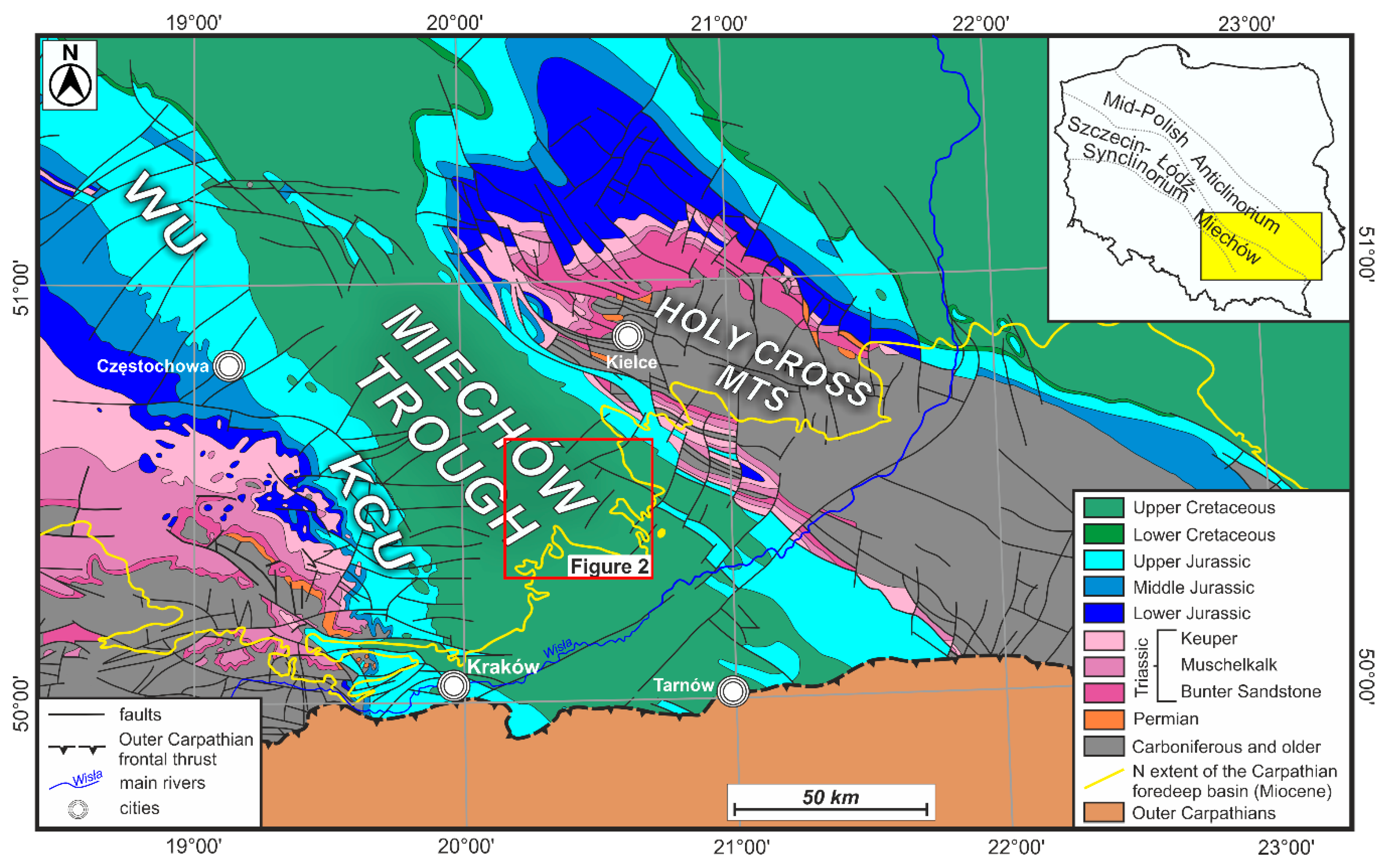
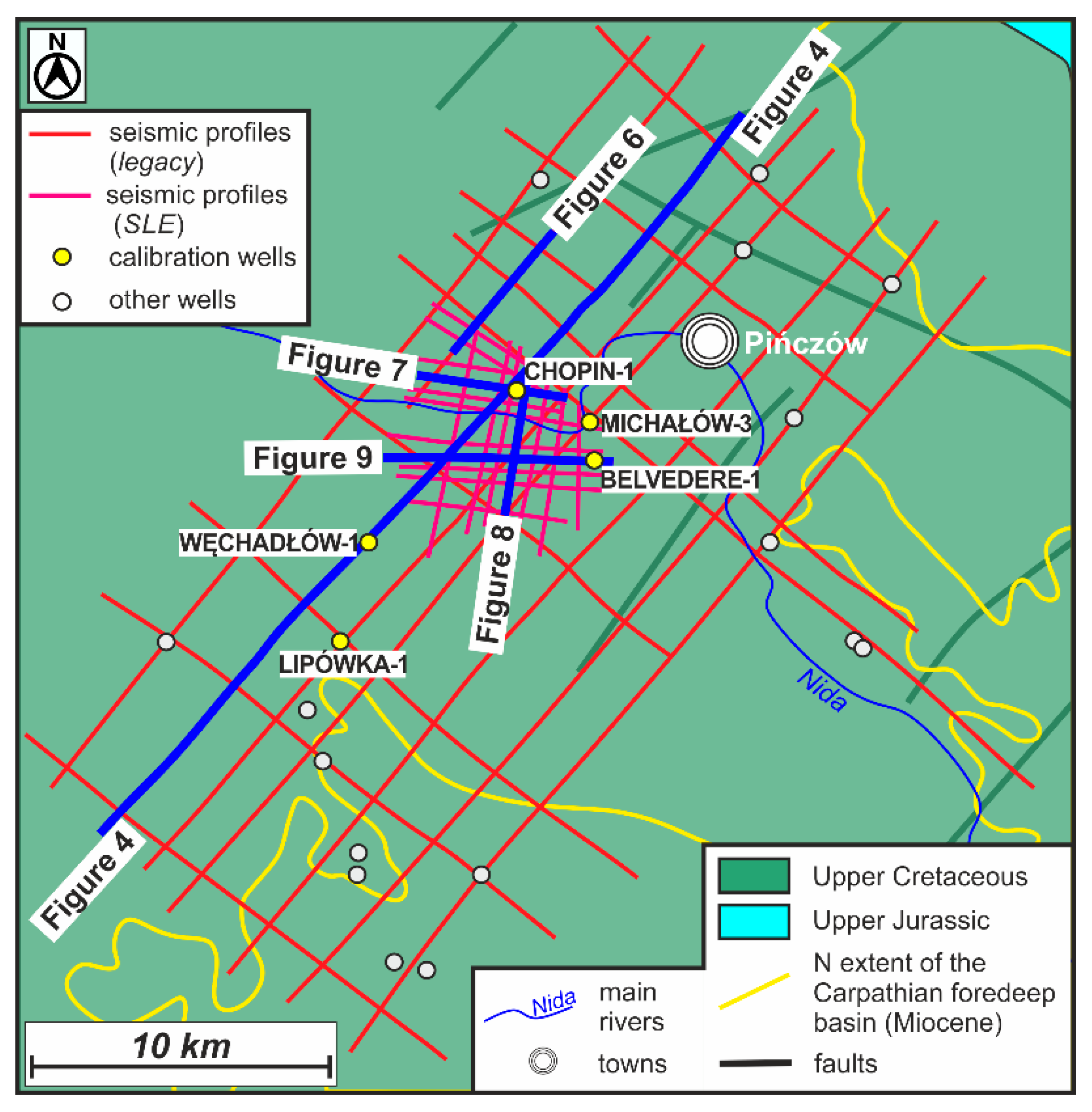
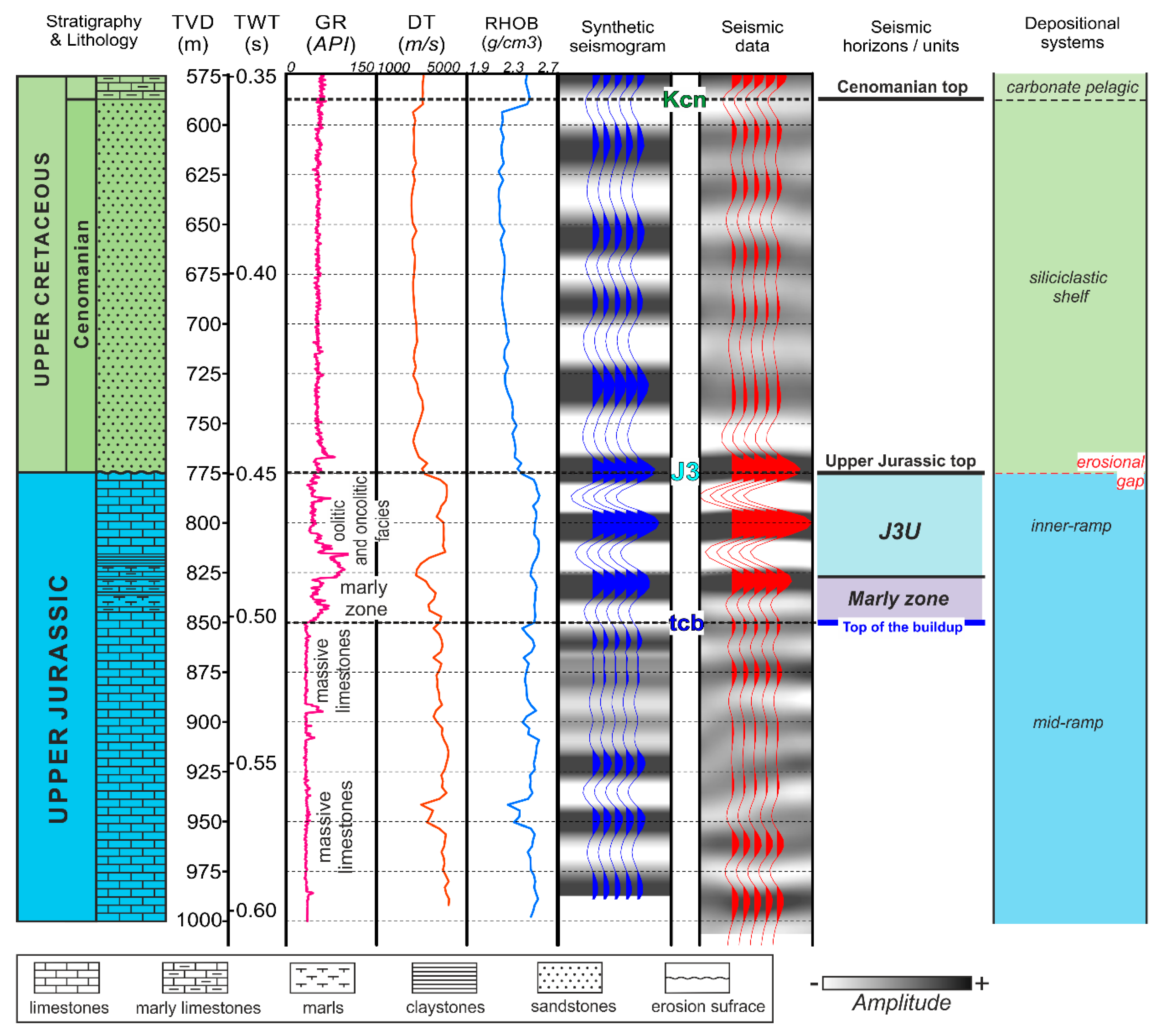
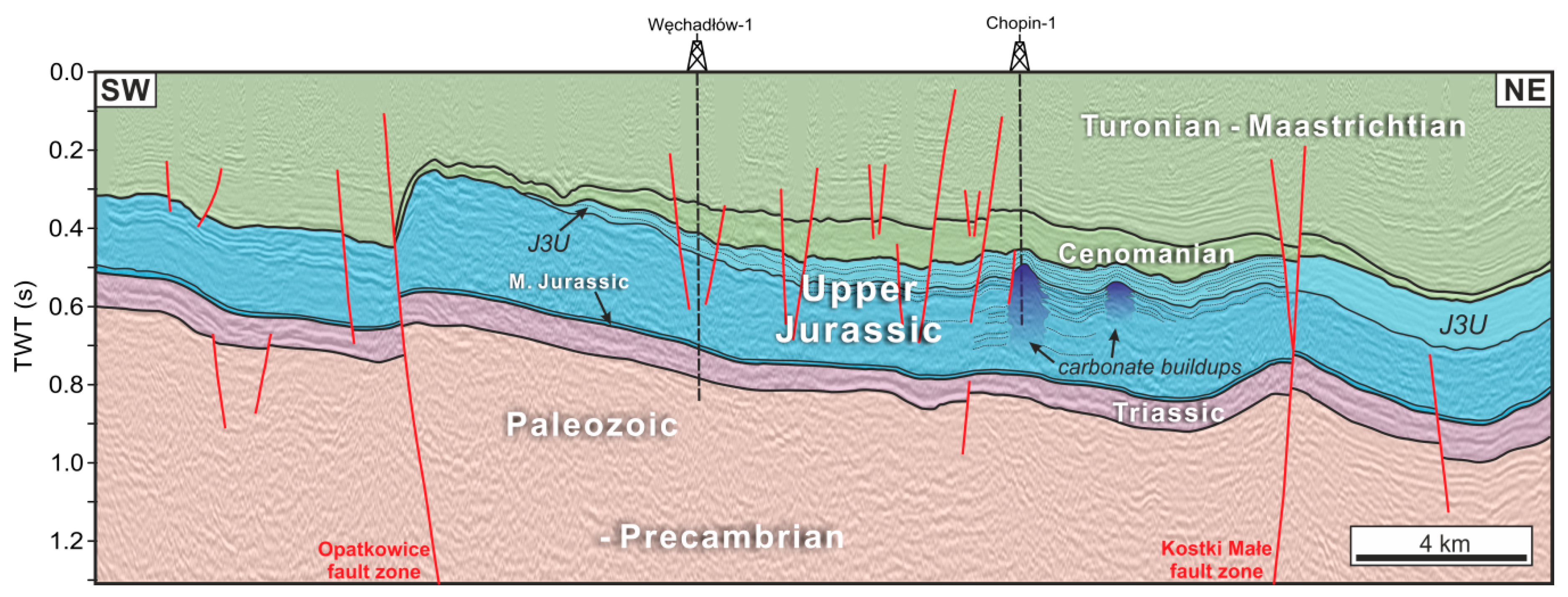
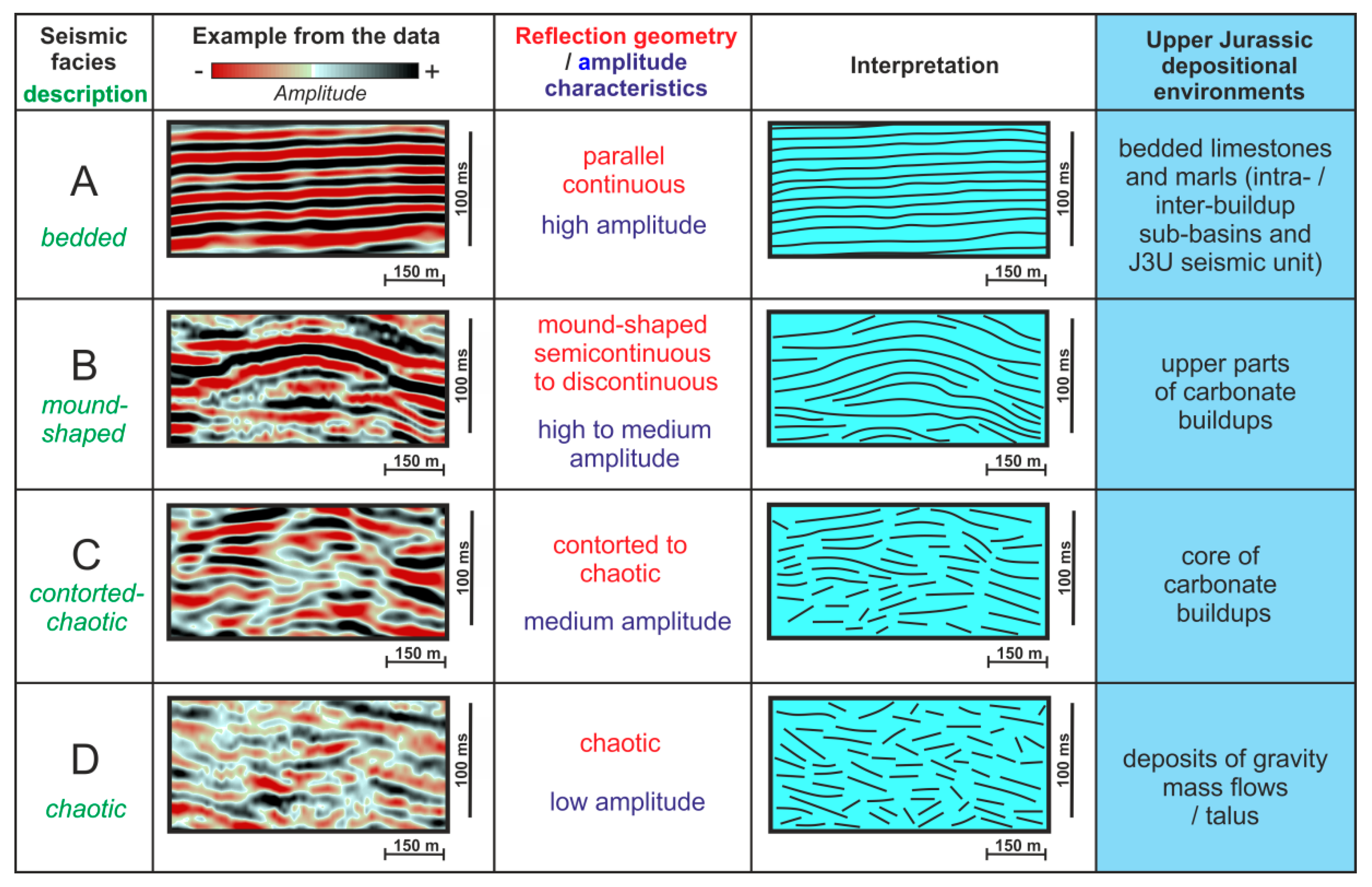
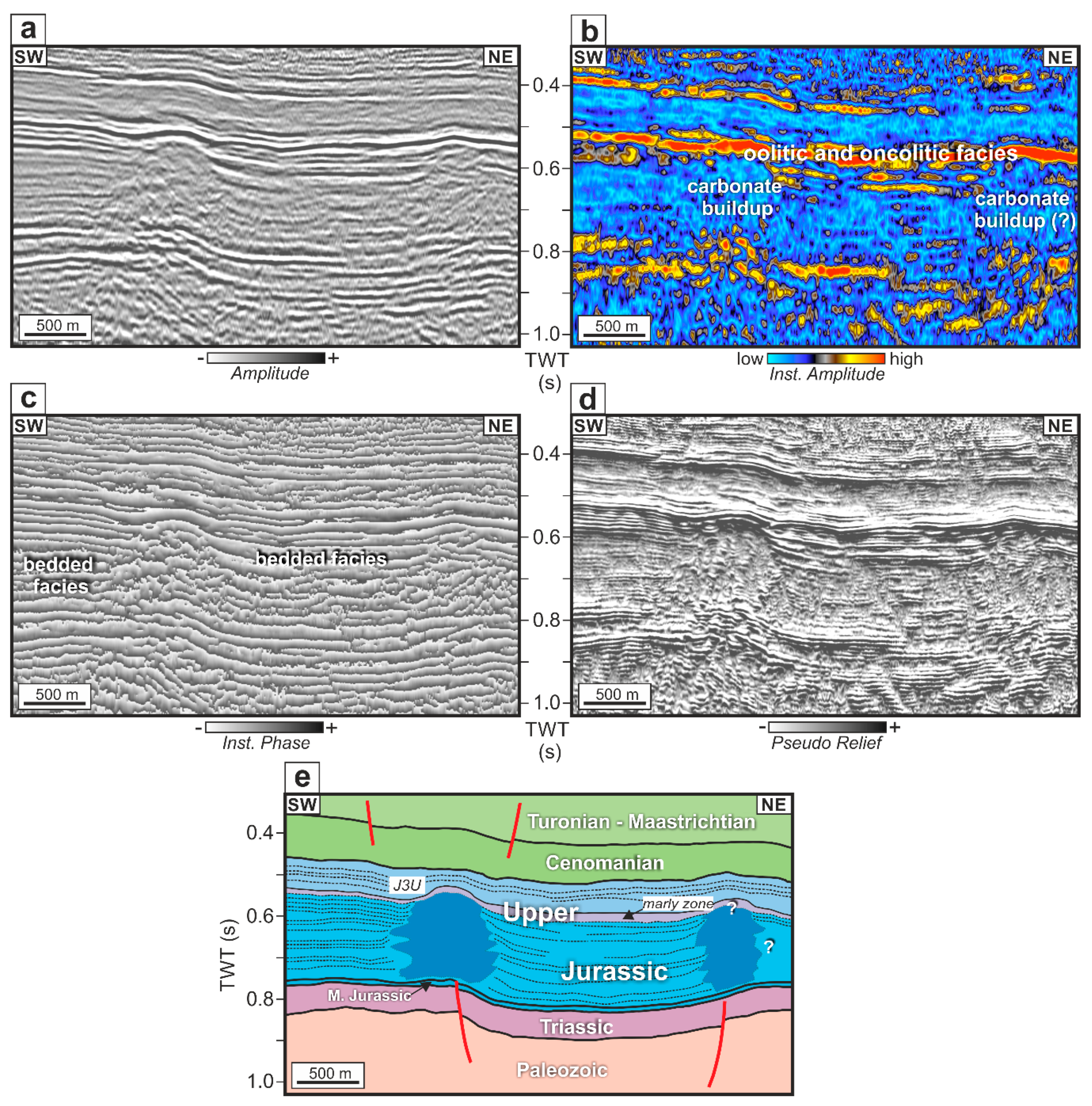
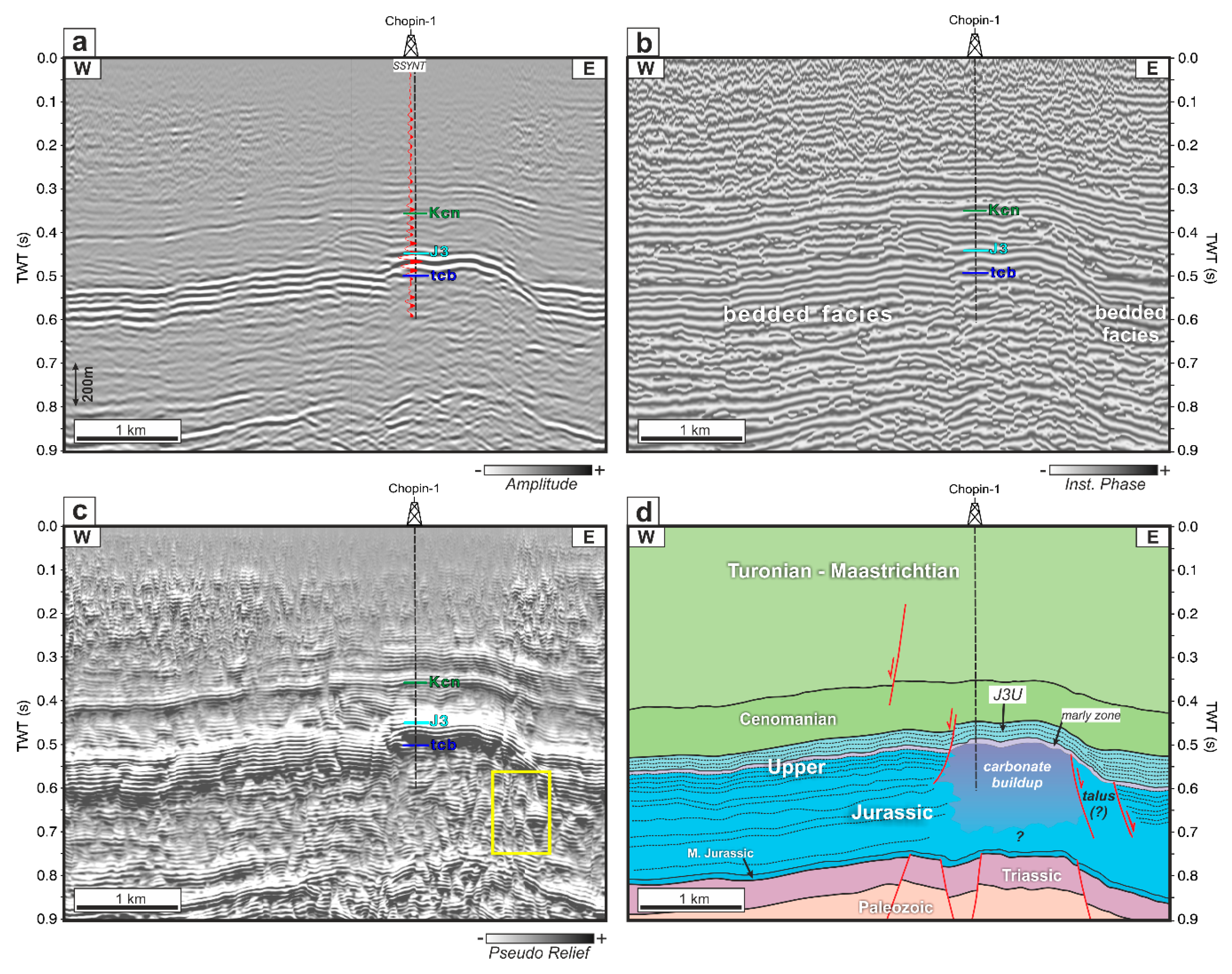
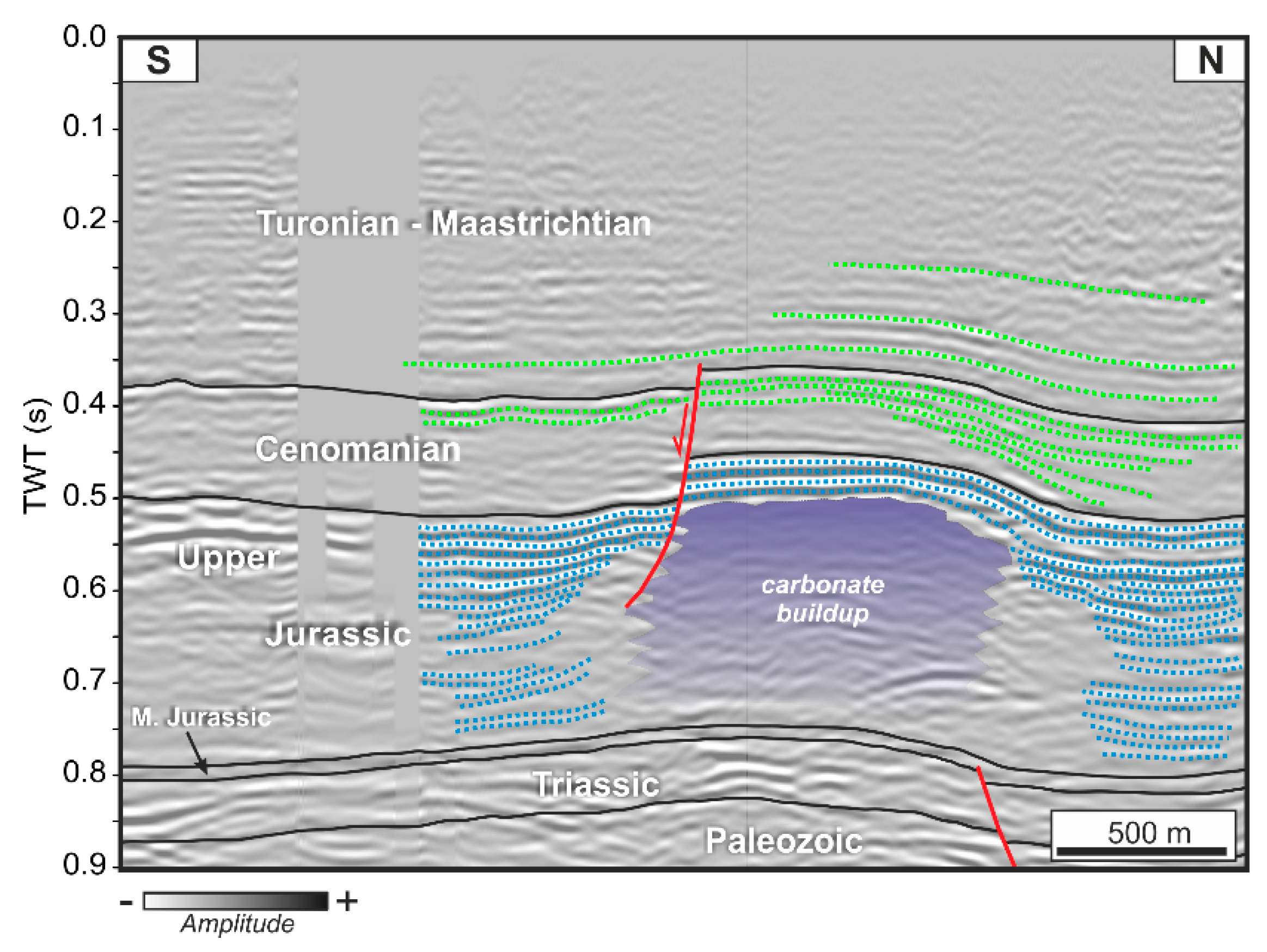
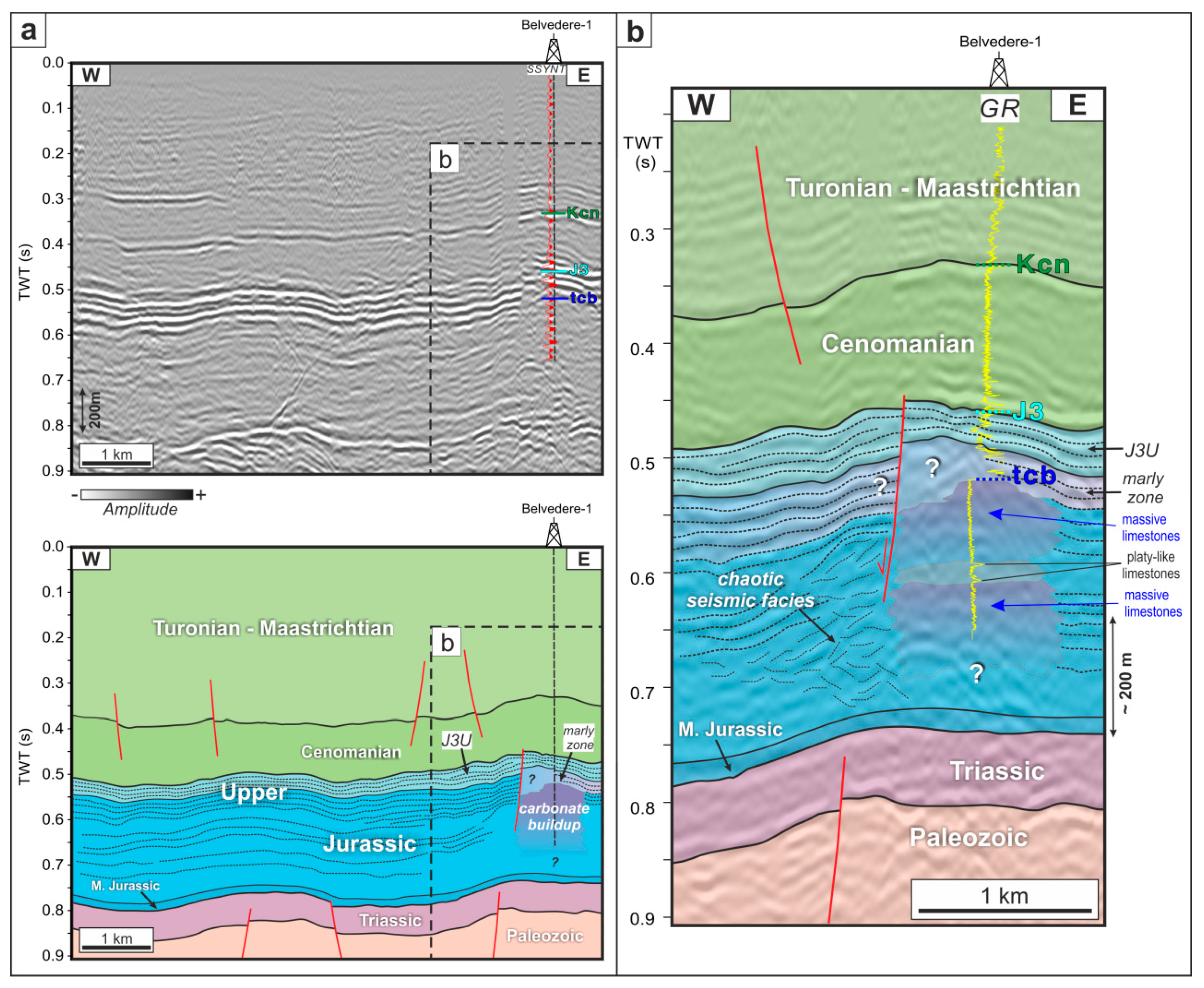
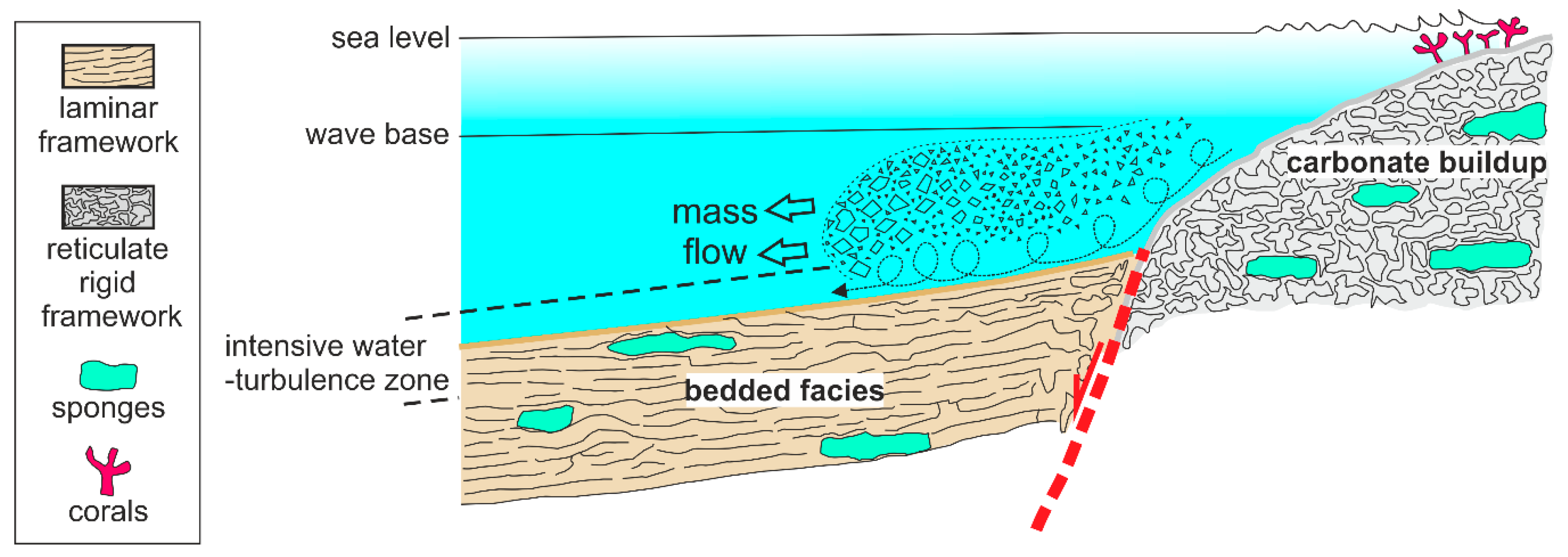
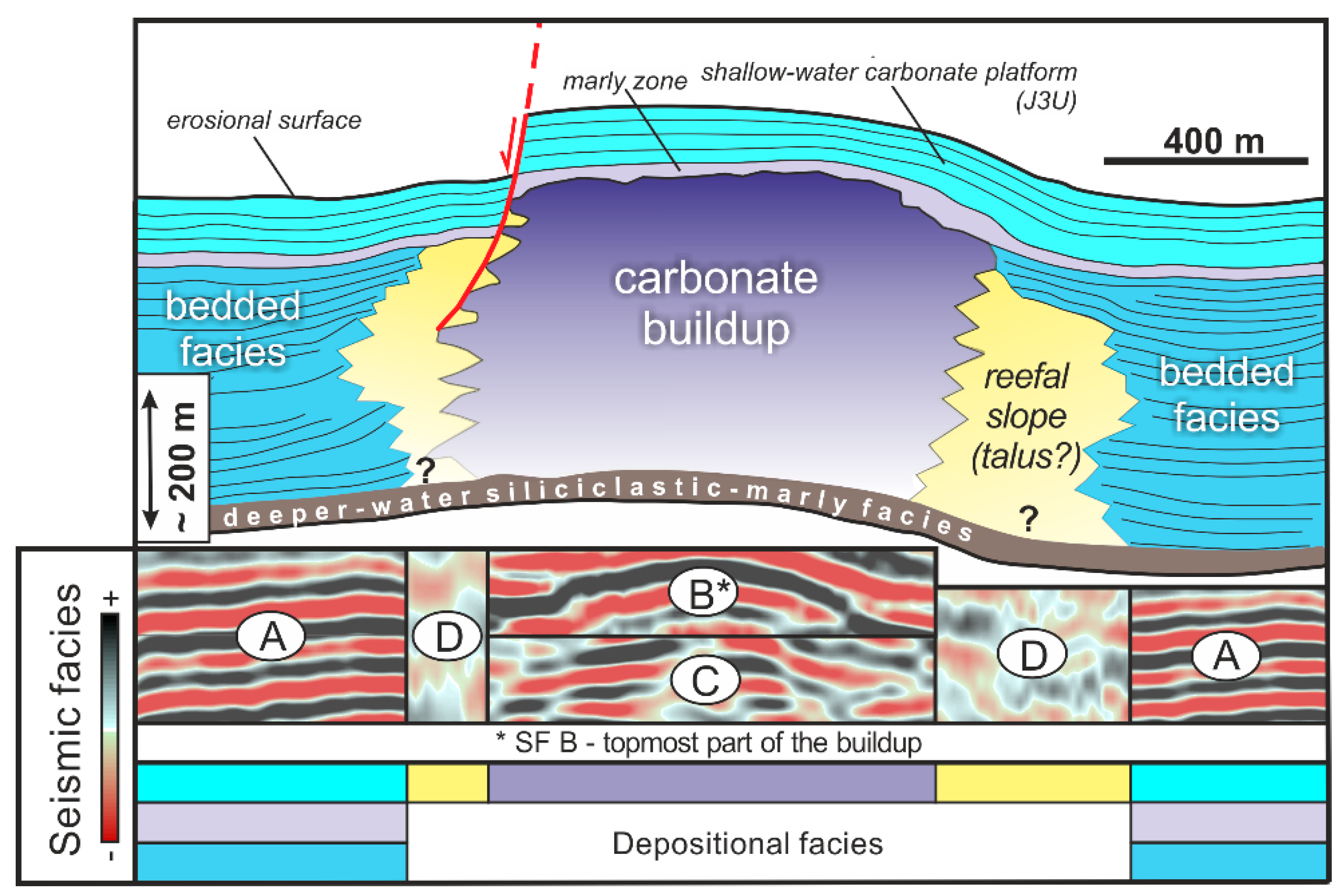
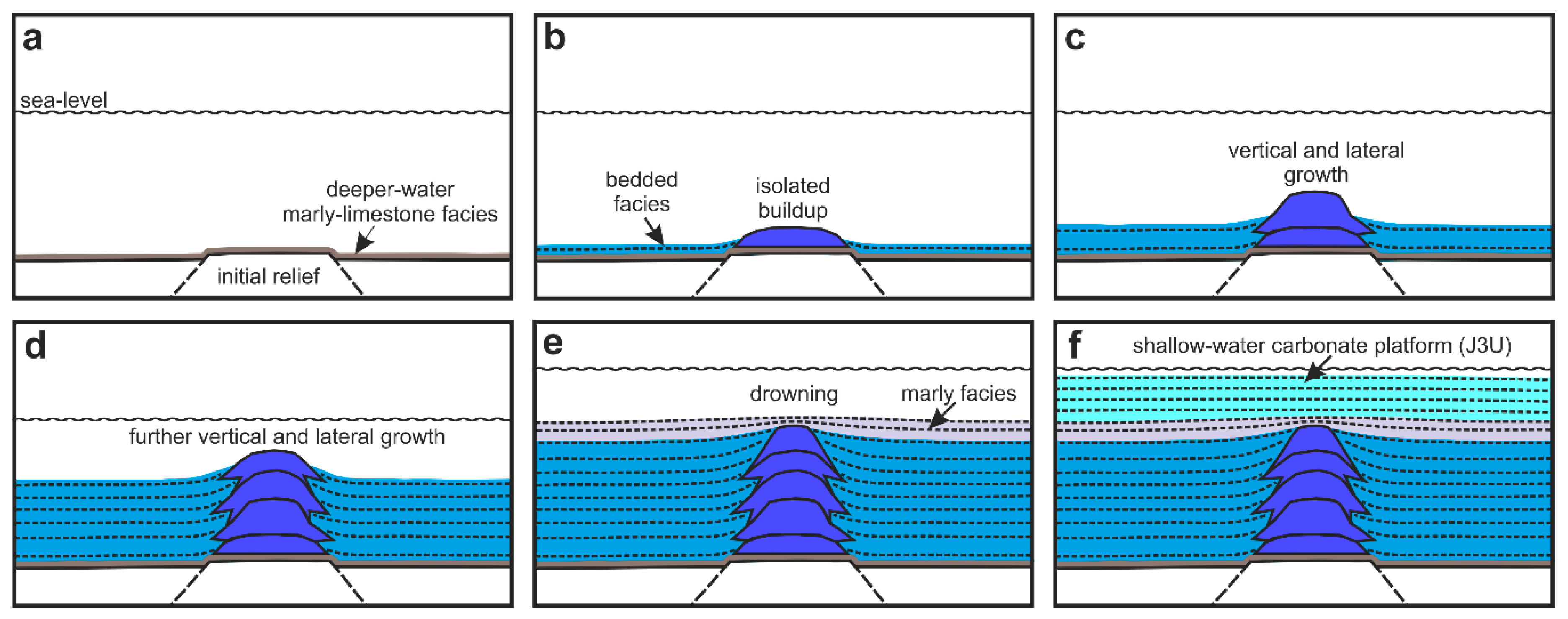
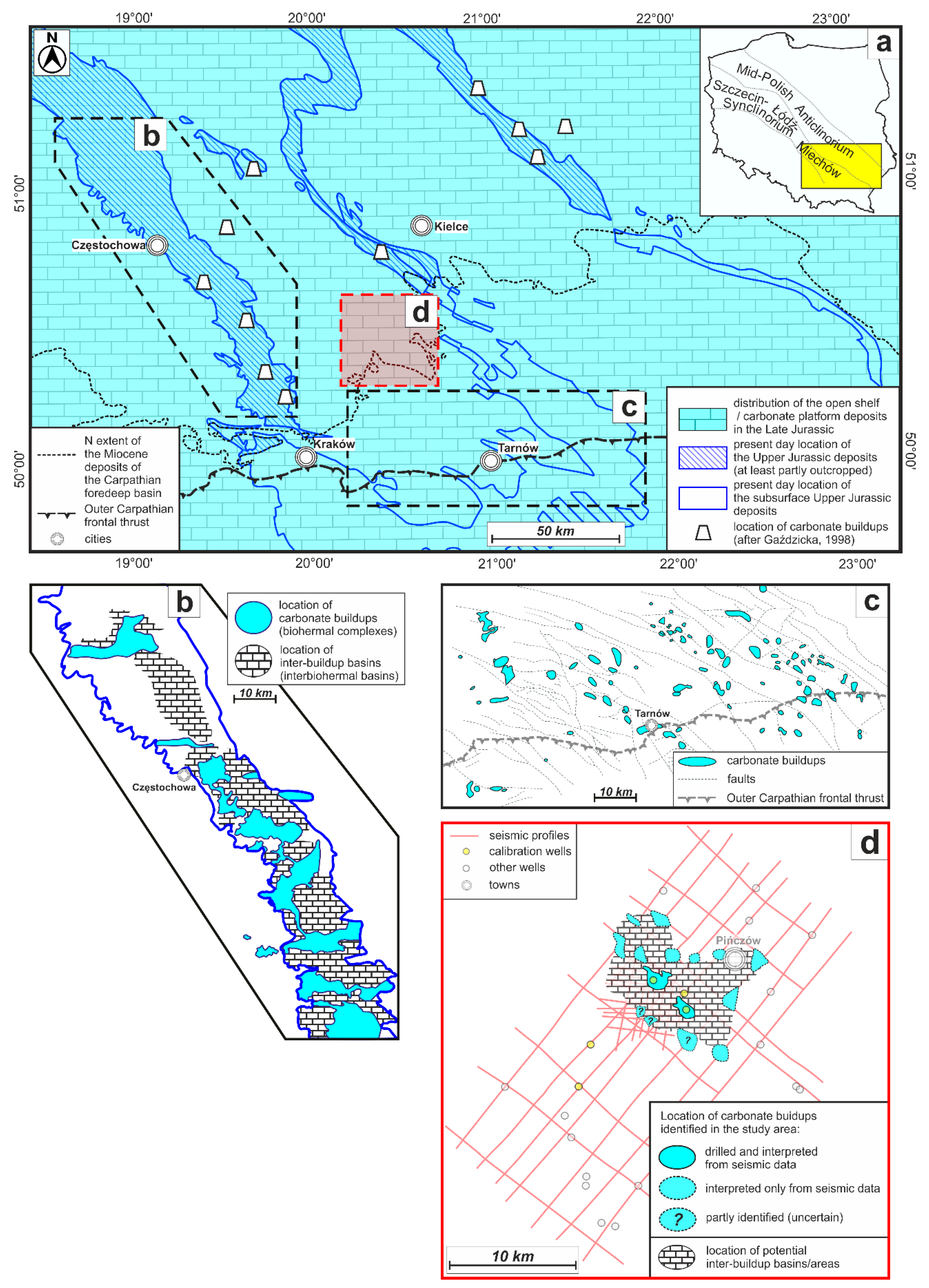
© 2020 by the authors. Licensee MDPI, Basel, Switzerland. This article is an open access article distributed under the terms and conditions of the Creative Commons Attribution (CC BY) license (http://creativecommons.org/licenses/by/4.0/).
Share and Cite
Słonka, Ł.; Krzywiec, P. Seismic Characteristics and Development of the Upper Jurassic Carbonate Buildups from the Miechów Trough (Southern Poland). Geosciences 2020, 10, 239. https://doi.org/10.3390/geosciences10060239
Słonka Ł, Krzywiec P. Seismic Characteristics and Development of the Upper Jurassic Carbonate Buildups from the Miechów Trough (Southern Poland). Geosciences. 2020; 10(6):239. https://doi.org/10.3390/geosciences10060239
Chicago/Turabian StyleSłonka, Łukasz, and Piotr Krzywiec. 2020. "Seismic Characteristics and Development of the Upper Jurassic Carbonate Buildups from the Miechów Trough (Southern Poland)" Geosciences 10, no. 6: 239. https://doi.org/10.3390/geosciences10060239
APA StyleSłonka, Ł., & Krzywiec, P. (2020). Seismic Characteristics and Development of the Upper Jurassic Carbonate Buildups from the Miechów Trough (Southern Poland). Geosciences, 10(6), 239. https://doi.org/10.3390/geosciences10060239





